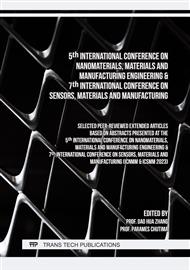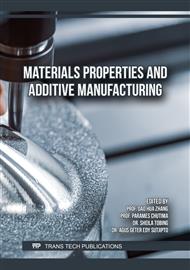p.87
p.95
p.105
p.113
p.121
p.127
p.133
p.139
p.147
Fatigue Resistance Assessment of WAAM Carbon Steel
Abstract:
This study presents a comprehensive exploration of the fatigue resistance of wire arc additive manufacturing (WAAM) carbon steel for lattice structures. Microstructural analysis unveils substantial grain dimensions characterized by a distinctive crystallographic configuration. These grains exhibit equiaxed characteristics, demonstrating uniform dimensions in all directions. The prevailing microstructure is dominated by ferrite grains. In tandem with the microstructural insights, hardness evaluations were conducted in correspondence with the part's deposition direction. The analysis of these measurements unveiled a consistent base material hardness of approximately 159 HV. The uniform distribution of hardness profiles supports the deduction that WAAM carbon steel uniformly embodies strength attributes. This congruence aligns harmoniously with the uniform microstructure evident in microscopic analyses. The yield strength of the WAAM carbon steel exhibits higher values in the build direction, peaking at 392 MPa. The bending fatigue tests revealed a fatigue limit approximating 180 MPa for WAAM carbon steel, evident in both the build and deposition directions. Fatigue strength of WAAM carbon steel mirrors that observed for reference material S355MC steel sheet.
Info:
Periodical:
Pages:
147-153
Citation:
Online since:
February 2024
Authors:
Price:
Сopyright:
© 2024 Trans Tech Publications Ltd. All Rights Reserved
Share:
Citation:



